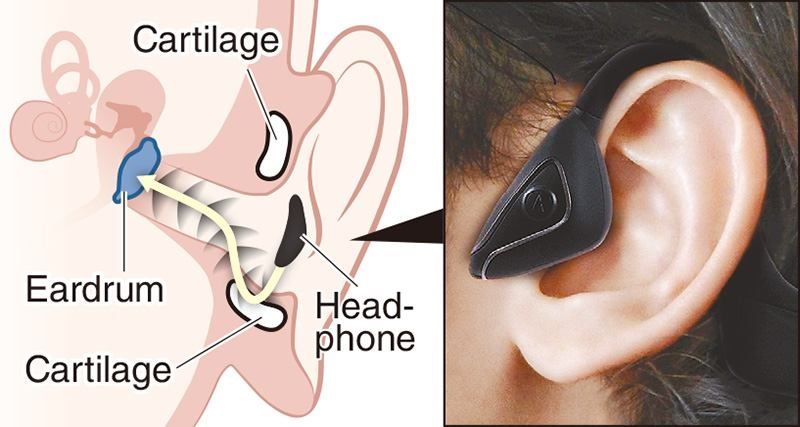
21:00 JST, November 19, 2022
A Tokyo-based audio equipment firm’s world-first, cartilage-conduction headphones have been attracting increasing attention since their October release.
Unlike over-ear or in-ear listening devices, Audio-Technica Corp.’s new wireless headphones hook over the ears and conduct sound via cartilage.
Cartilage conduction has been dubbed the “third auditory pathway,” after air conduction, in which sound waves vibrate the eardrum and pass information to the inner ear and bone conduction, in which vibrations in the skull are received directly by the inner ear before being sent to the brain via the auditory nerve.
The new pathway was discovered in 2004 by Nara Medical University President Hiroshi Hosoi.
Since sound can be transmitted via cartilage, the new headphones do not require a lot of pressure to be applied, unlike bone conduction, in which strong pressure is used to press the headphones to a user’s skull.
Cartilage conduction is also used in some hearing aids because it is less prone to noise and provides a natural sound similar to that of air conduction.
Audio-Technica developed the headphones (model ATH-CC500BT) under a license agreement with CCH Sound, Inc., a Seika, Kyoto Prefecture-based firm that owns a patent related to cartilage conduction. The new product, which is the first to put cartilage conduction to practical use as a consumer product, retails for ¥17,600.
The headphones have been well received. As there is no need to cover or block the ear canal, users do not miss out on ambient sounds, such as train announcements while commuting.
“They’re selling better than we expected,” said an official at the company. “Cartilage-conduction headphones will highly likely become a mainstream technology in the future.”
Several other electronics manufacturers and tech companies reportedly have shown interest in cartilage conduction.
Auditory pioneer Hosoi, 74, said: “Compared to the visual realm, technology developments in hearing have lagged. Cartilage conduction is expected to be used in the metaverse and underwater, so we’d like more people to know about the technology.”
"Business" POPULAR ARTICLE
-

Tokyo Economic Security Forum to Hold Inaugural Meeting Amid Tense Global Environment
-

Keidanren Chairman Yoshinobu Tsutsui Visits Kashiwazaki-Kariwa Nuclear Power Plant; Inspects New Emergency Safety System
-

Imports of Rare Earths from China Facing Delays, May Be Caused by Deterioration of Japan-China Relations
-

University of Tokyo Professor Discusses Japanese Economic Security in Interview Ahead of Forum
-

Japan Pulls out of Vietnam Nuclear Project, Complicating Hanoi’s Power Plans
JN ACCESS RANKING
-

Tokyo Economic Security Forum to Hold Inaugural Meeting Amid Tense Global Environment
-

Keidanren Chairman Yoshinobu Tsutsui Visits Kashiwazaki-Kariwa Nuclear Power Plant; Inspects New Emergency Safety System
-

Imports of Rare Earths from China Facing Delays, May Be Caused by Deterioration of Japan-China Relations
-

University of Tokyo Professor Discusses Japanese Economic Security in Interview Ahead of Forum
-

Japan Pulls out of Vietnam Nuclear Project, Complicating Hanoi’s Power Plans

























